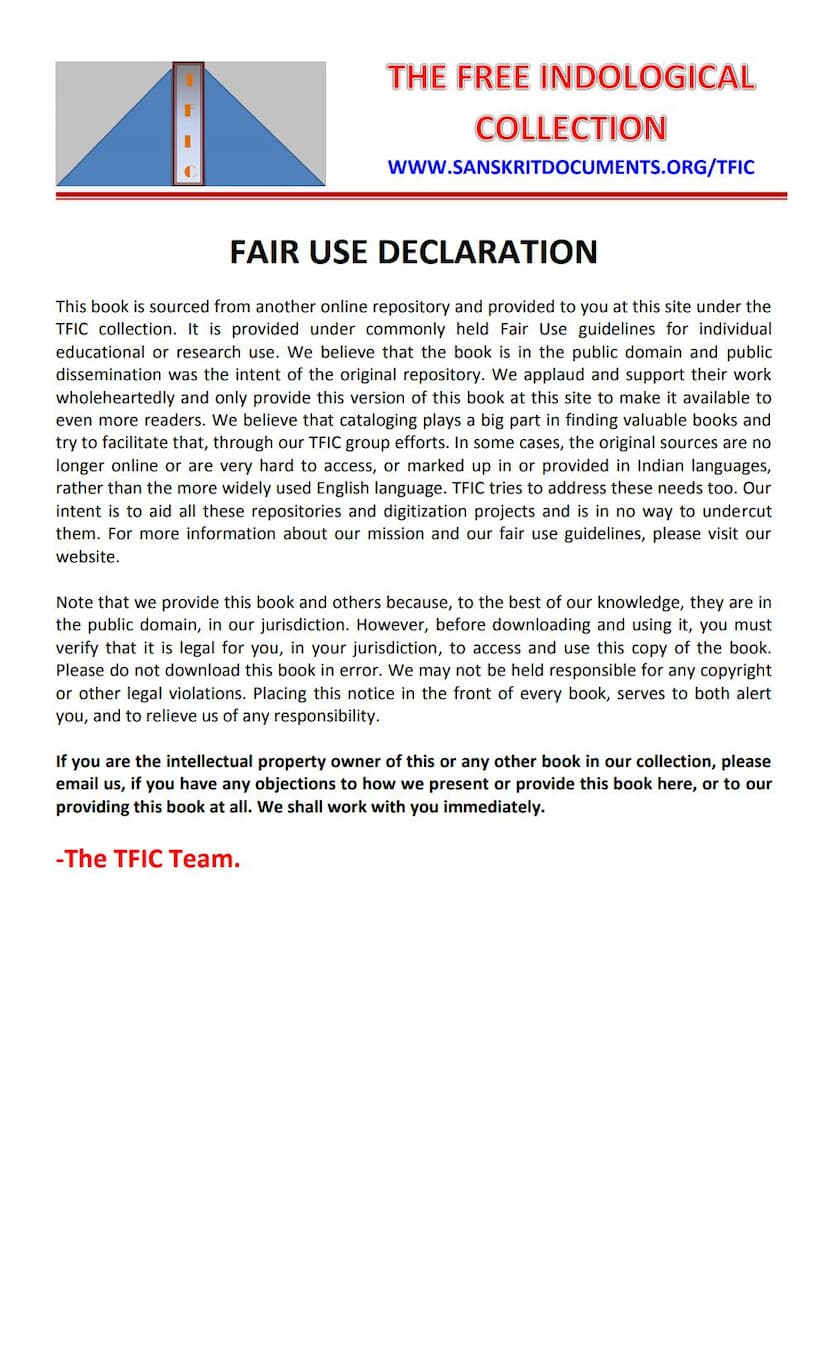Agam 40 Mool 01 Aavashyak Sutra
Added to library: September 1, 2025

Summary
This document is a Hindi translation and commentary of the Āvaśyaka Sūtra, a fundamental Jain text, compiled by Upadhyaya Shri Atmaramji Maharaj and published by Lala Munshiram Ziledar. The publication date is 1915 AD / 2441 Mahavir Nirvana Era.
The book is presented as a guide for Shravakas (lay followers) to perform their daily Pratikraman (repentance ritual).
Here's a comprehensive summary of the content, based on the provided pages:
Core Purpose and Structure:
- Aims to fulfill a need: The foreword highlights that this work aims to provide the Jain community with a well-compiled Hindi explanation of the Āvaśyaka Sūtra, which details daily prayer and rituals.
- Focus on Lay Followers: The "Pratham Bhag" (First Part) specifically focuses on the Pratikraman for Shravakas and Shravikas.
- Six Essential Duties (Ṣaṭ Āvaśyaka): The text explains that Lord Mahavir himself laid down six essential daily duties, which are crucial for spiritual progress. These are:
- Sāmāyika: Equanimity or meditation.
- Chaturviṃśati Stava: Praise of the 24 Tirthankaras.
- Vandanā: Salutations and reverence.
- Pratikramaṇa: Repentance for past transgressions.
- Kāyotsarga: Release of the body and mind from attachment, a form of ascetic practice.
- Pratyākhyāna: Renunciation or abstention from certain actions or objects.
- Benefits of each Āvaśyaka: The author quotes verses from the Uttarādhyayana Sūtra to explain the benefits of performing each of the six Āvaśyakas, such as overcoming sinful activities, purification of faith, shedding karmic bondage, and achieving inner peace.
Key Concepts and Explanations:
- Āśrava and Saṃvara: The text touches upon the concepts of Āśrava (influx of karmas) and Saṃvara (cessation of karmas) as foundational to understanding Pratikramaṇa, which aims to stop Āśrava and promote Saṃvara.
- Four Nīkṣēpas of Āvaśyaka: It mentions the four ways Āvaśyaka Sūtra is understood: Nāmāvaśyaka, Sthāpanāvaśyaka, Dravyāvaśyaka, and Bhāvāvaśyaka. Bhāvāvaśyaka (internal, spiritual aspect) is emphasized as essential.
- Purity (Śuddhi): The importance of purity in Dravya (material objects used in rituals), Kṣētra (place of ritual), Kāla (time of ritual), and Bhāva (mental state) is stressed for the effectiveness of the Āvaśyaka.
- The Namokāra Mantra: The significance and correct pronunciation/derivation of the Namokāra Mantra (Namo Arihantāṇaṃ, Namo Siddhānaṃ, Namo Āyariyānaṃ, Namo Uvajjhāyānaṃ, Namo Lōe Sabbasāhūṇaṃ) are explained in detail.
- The Six Āvaśyakas for Shravakas (Detailed):
- Sāmāyika: Described as a state of equanimity and freedom from sinful activities. The ritualistic steps and associated mantras are outlined, including the importance of intention and the careful recitation of specific verses. The author provides a detailed breakdown of the mantras to be recited during Sāmāyika.
- Chaturviṃśati Stava: The recitation of verses praising the 24 Tirthankaras is explained as a means to purify faith (Darśana Viśuddhi).
- Vandanā: The ritual of salutation and the accompanying mantras are described, emphasizing respect for the spiritual preceptors and the spiritual path.
- Pratikramaṇa: This section extensively details the Pratikramaṇa ritual, including the confession of specific transgressions (Aticāra) related to the twelve vows of a householder. It lists numerous aticāras for each vow (e.g., Prāṇātipāta Viramaṇa Vrata, Mr̥ṣāvāda Viramaṇa Vrata, etc.) and the corresponding mantras for seeking forgiveness (Mi chchhāmi Dukkaḍaṃ).
- Kāyotsarga: Explained as a practice of physical stillness and mental detachment for purification, with specific mantras and guidelines for its performance.
- Pratyākhyāna: This covers various forms of renunciation and abstention, including daily (Muhūrta), two-prahar (Purimcha), and other forms of fasting or dietary restrictions. The text outlines the specific mantras and āgāras (exceptions) for each type of Pratyākhyāna.
- The Twelve Vows (Dvādaśa Vrata): The Pratikramaṇa section delves deeply into the aticāras associated with the five Anuvaratas (minor vows) and the three Guṇavratas (virtue vows), four Śīkṣāvratas (disciplinary vows), and the concept of eighteen Pāpasthānas (sinful actions).
- The Twelve Vows in Detail: The text dedicates significant portions to explaining the aticāras for each of the twelve vows, providing specific examples and mantras for repentance. These vows cover:
- Abstinence from gross violence (Prāṇātipāta Viramaṇa).
- Abstinence from gross falsehood (Mr̥ṣāvāda Viramaṇa).
- Abstinence from gross theft (Adattādāna Viramaṇa).
- Abstinence from gross sexual misconduct (Brahmacharya Viramaṇa).
- Abstinence from gross accumulation (Parigraha Viramaṇa).
- Abstinence from restricting directions (Diśi Viramaṇa).
- Abstinence from limiting enjoyment and use (Upabhoga Paribhoga Viramaṇa).
- Abstinence from sinful activities (Anartha Daṇḍa Viramaṇa).
- Sāmāyika (Equanimity).
- Deśāvakāśika (Limited time/space restraint).
- Paushadha (Fasting days).
- Atithi Saṃvibhāga (Sharing with ascetics).
- Sanllekhanā: The final section describes Sanllekhanā, the practice of gradual self-starvation as a spiritual discipline, particularly undertaken during the end of life. It outlines the rituals and mental preparedness required.
Key Themes:
- Devotion and Reverence: Strong emphasis on devotion to the Tirthankaras, the Ācāryas, and the Sangha.
- Self-Reflection and Repentance: The core of Pratikramaṇa is introspection and sincere regret for past actions.
- Discipline and Restraint: The text provides a framework for disciplined living through the observance of vows and rituals.
- Spiritual Purity: The attainment of purity through adherence to the Āvaśyakas is a central theme.
- Layperson's Path: The book is practical and accessible, offering guidance for lay Jains to navigate their spiritual journey.
In essence, this is a comprehensive manual for Jain lay followers on how to perform their daily spiritual duties (Āvaśyaka), with a particular focus on understanding and practicing Pratikramaṇa, the ritual of repentance. It breaks down the six essential practices and elaborates on the detailed transgression (aticāra) confession for each of the twelve vows.